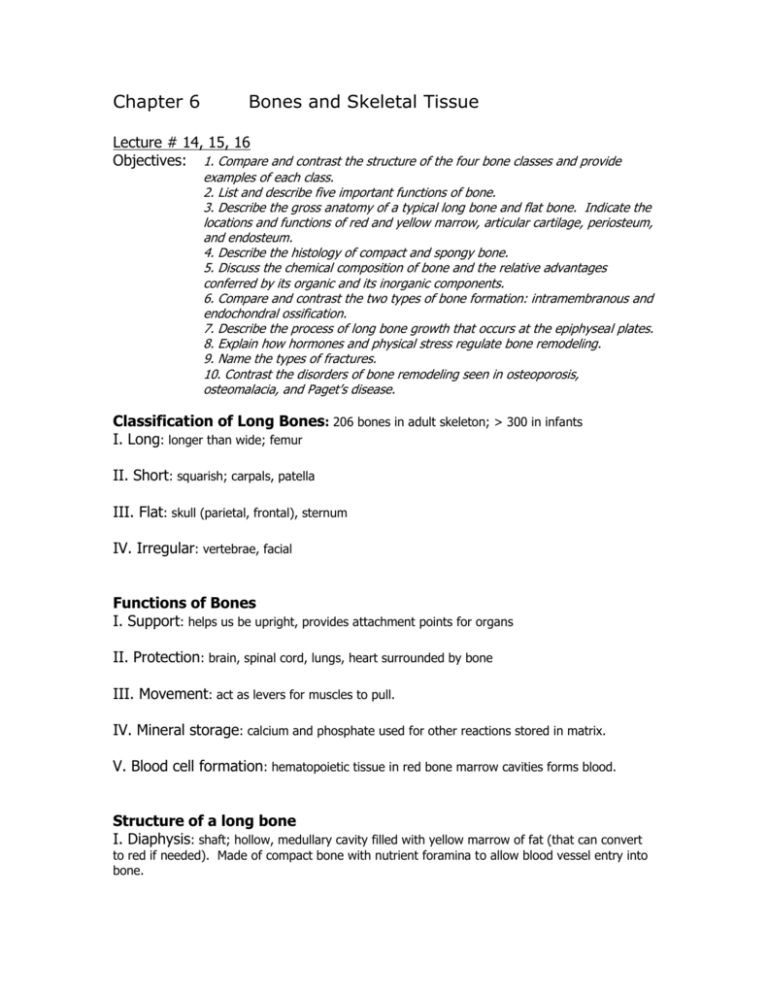Chapter 6 Bones - eacfaculty.org
advertisement

Chapter 6 Bones and Skeletal Tissue Lecture # 14, 15, 16 Objectives: 1. Compare and contrast the structure of the four bone classes and provide examples of each class. 2. List and describe five important functions of bone. 3. Describe the gross anatomy of a typical long bone and flat bone. Indicate the locations and functions of red and yellow marrow, articular cartilage, periosteum, and endosteum. 4. Describe the histology of compact and spongy bone. 5. Discuss the chemical composition of bone and the relative advantages conferred by its organic and its inorganic components. 6. Compare and contrast the two types of bone formation: intramembranous and endochondral ossification. 7. Describe the process of long bone growth that occurs at the epiphyseal plates. 8. Explain how hormones and physical stress regulate bone remodeling. 9. Name the types of fractures. 10. Contrast the disorders of bone remodeling seen in osteoporosis, osteomalacia, and Paget’s disease. Classification of Long Bones: 206 bones in adult skeleton; > 300 in infants I. Long: longer than wide; femur II. Short: squarish; carpals, patella III. Flat: skull (parietal, frontal), sternum IV. Irregular: vertebrae, facial Functions of Bones I. Support: helps us be upright, provides attachment points for organs II. Protection: brain, spinal cord, lungs, heart surrounded by bone III. Movement: act as levers for muscles to pull. IV. Mineral storage: calcium and phosphate used for other reactions stored in matrix. V. Blood cell formation: hematopoietic tissue in red bone marrow cavities forms blood. Structure of a long bone I. Diaphysis: shaft; hollow, medullary cavity filled with yellow marrow of fat (that can convert to red if needed). Made of compact bone with nutrient foramina to allow blood vessel entry into bone. II. Epiphysis: ends; made of external layer of compact bone, then inner portion is spongy bone filled with red marrow. Epiphyses are covered with articular cartilage. Epiphyses are covered with articular cartilage. Epiphyseal line is remnant of growth plate. III. Membranes A. Periosteum: dense irregular connective tissue (DICT) outside; inner layer has osteoblasts and osteoclasts. Supplied with nerves, lymph vessels, blood vessels, and secured with Sharpey’s fibers. B. Endosteum: DICT as internal lining, covers spongy bone, lines canals, etc. Hematopoietic Tissue: stem cells that produce all the formed elements (cells) of blood. Microscopic Structure of Bone I. Compact Bone A. Osteon or Haversian system: series of concentric rings of matrix around Haversian canal. 1. Lamella: ring of matrix of calcium and phosphate. 2. Haversian (central) canal: center of osteon with artery, vein, nerve; it is the vertical canal. 3. Volkmann’s canal: horizontal canal that carries blood vessel toward osteon 4. Osteocytes: cells (bone) that are imbedded in matrix ( --blasts, and –clasts) 5. Lacuna: open spaces in between lamellae where osteocytes are found 6. Canaliculi: small “cracks” in lamellae that connect the osteocytes with one another. II. Spongy Bone: porous bone where trabeculae (struts) align precisely along lines of stress to help reinforce bone. Made of irregularly spaced lamellae, osteocytes and canaliculi. A. Diploë: Two layers of compact bone with spongy bone sandwiched in between; it is the composition of flat bones. Chemical Composition of Bone Organic: composed of collagen, osteocytes, proteoglycans, glycoproteins. Provide flexibility and tensile strength. Inorganic: composed of calcium in the form of hydroxyapetite or mineral salts (CaPO4). Tiny crystals around collagen fibers provide hardness to resist compression. Bone Development: osteogenesis: embryonic formation of bone Ossification: repair or remodeling I. Intramembranous ossification: by 8 weeks the embryonic skeleton is made of fibrous connective membranes (the flat bones) and hyaline cartilage. Fibrous membranes become diploë through intramembranous ossification. Skull bones and clavicles form this way. II. Endochondral ossification: hyaline cartilage becomes endochondral bone. 1. 2. 3. 4. 5. Primary ossification center occurs in diaphysis Cells calcify, spongy bone develops Diaphysis elongates Secondary ossification centers occur in epiphyses Hyaline cartilage is completely replaced by bone except for articular cartilage and epiphyseal plates III. Growth in length of long bone: Epiphyseal plate cartilage (hyaline) away from the diaphysis carries out fast, efficient growth (reproduction of chondrocytes), pushing away the epiphyses from diaphysis. Bone remodeling occurs with osteoblasts and osteoclasts in periosteum and endosteum, resulting in a properly shaped bone. Epiphyseal plate becomes bone as chondrocytes ossify Thickness in bone occurs as a response to stress and weight (muscle activity) Hormonal Regulation of Growth and Remodeling 1. Growth hormone controls growth during infancy and childhood 2. Thyroxine modulates growth for proper proportions 3. Sex hormone are responsible for growth spurt in adolescence (along with GH) We recycle 5-7% of bone mass every week due to the action of calcitonin (primarily in youth) and PTH. Types of fractures 1. 2. 3. 4. 5. 6. comminuted: 3 or more pieces (aged) spiral: ragged, twisting break (sports) depressed: pressed inward (skull fracture) compression: crushed (osteoporosis) epiphyseal: separation @ plate (children) greenstick: only one side breaks (children) Repair: 1. 2. 3. 4. Hematoma formation (clot) Fibrocartilaginous callus forms Bony callus forms Bone remodeling Homeostatic imbalances I. Osteomalacia and rickets: insufficient mineralization of bone due to lack of Vit D and therefore lack of calcium absorption. In children, hyaline cartilage doesn’t ossify. II. Osteoporosis: in postmenopausal women and older men due to resorption of bone exceeding deposition. Osteoclast activity is greater. Normally, estrogen inhibits osteoclasts. III. Paget’s disease: hastily formed bone that does not become compact and then does not have proper mineralization and results in spotty weakness. IV. Osteogenesis imperfecta: genetic disorder involving the lack of or improperly formed collagen in bones






